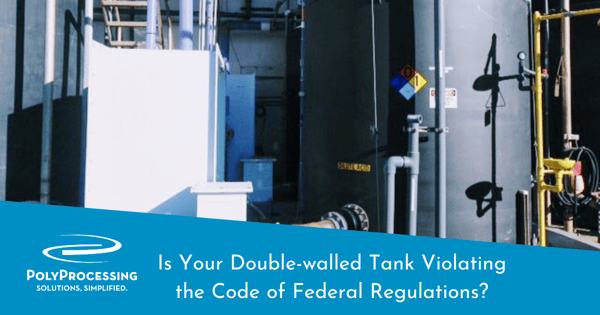Is Your Double-walled Tank Violating the Code of Federal Regulations?
Your double walled tank could be violating the Code of Federal Regulations (CFR) without your knowledge — even if there’s nothing wrong with the tank itself. The CFR contains requirements designed to protect the environment from exposure to hazardous chemicals.

Secondary containment systems must meet certain standards, and there are regulations specifically for double walled chemical storage tanks. But many organizations are unknowingly using double wall tanks that violate these requirements.
What if You’re in Violation of 40 CFR 264?
It’s important to ensure that your chemical storage systems are compliant with federal and local requirements. Companies that violate CFR regulations could face civil penalties and injunctions in the U.S. District Court.
Civil penalties are based on the seriousness of the violation (and other factors), but the fees can be steep — as high as tens of thousands of dollars per day, per violation.
Whenever you purchase a storage tank, make sure the manufacturer can engineer a system that meets both federal and local regulations.
40 CFR 264 Requirements for Double walled Tanks
40 CFR 264.193 states that double walled tanks must be:
- (i) Designed as an integral structure (i.e., an inner tank completely enveloped within an outer shell) so that any release from the inner tank is contained by the outer shell;
- (ii) Protected, if constructed of metal, from both corrosion of the primary tank interior and of the external surface of the outer shell; and
- (iii) Provided with a built-in continuous leak detection system capable of detecting a release within 24 hours, or at the earliest practicable time, if the owner or operator can demonstrate to the Regional Administrator, and the Regional Administrator concludes, that the existing detection technology or site conditions would not allow detection of a release within 24 hours.
Paragraph (i) is where many organizations get into trouble. While the tank itself may meet requirements, the release from the inner tank may not. Let’s explore why.
Double wall containment is only as secure as its weakest link. The most likely spot for a leak isn’t the tank wall itself, but the drain outlet fitting on the lower section of the tank wall. Since the tank wall must be cut (and thus compromised) to install a fitting, that connection is more susceptible to pressure and vibration and can become vulnerable to failure.
Many tank engineers don’t understand the requirements of 40 CFR 264, and they specify transition fittings that aren’t able to contain leaks at the weakest point. Release from the inner tank may not be contained by the outer shell, and could violate the regulations.
Peace of Mind with Poly Processing
Poly Processing’s SAFE-Tank® is a double walled storage system that provides a minimum of 110-percent secondary containment. The tank-within-a-tank solution prevents contaminants from entering the interstitial space between the two tanks, preserving the spilled liquid and allowing you to use the entire supply without losing inventory.
The SAFE-Tank meets and exceeds federal regulations — in fact, Poly Processing may be the only tank manufacturer that meets 40 CFR 264, because no other company offers a fitting like the Bellows Transition Fitting.

The Bellows Transition Fitting features a flexible expansion joint that is in line with the outlet pipe, which runs through both tanks. The Containment Bellows is a small containment wall or shell around the outlet pipe, which attaches to the outer tank. The inner tank can expand and contract as needed.
The transition fitting fully contains both the fitting and piping from the inner tank, through the outer tank, to the outlet. If the fitting or any of the seals becomes overstressed and fails, the leak is contained inside the bellows and flows back to the containment space between the inner and outer tank. Such a breach would also trigger the leak detection sensor (as required by 40 CFR 264.193).
Safety Beyond Federal Regulations
40 CFR is a federal code, but local regulations may be more stringent. Always be sure to meet the highest standards that apply to your jurisdiction.
If your local requirements are more strict than federal regulations, Poly Processing’s tanks should already be compliant. In the small chance that they don’t meet regulations, we’re able to work with you to design and engineer a tank system that meets or exceeds most requirements.
Of course, installing a SAFE-Tank with the Bellows Transition Fitting goes beyond complying with regulations. It’s also about protecting your personnel and the environment. Even without the CFR, containing hazardous chemicals at every vulnerability is the right thing to do.
Talk to a chemical tank specialist today for assistance on designing your compliant tank system.
- July 20, 2020
- Topics: Fittings and Accessories, Tank Design and Materials, Chemical Storage
About Poly Processing
Posts By Topic
Tech Talk Podcast Episodes
Subscribe By Email
Recent Posts
- Maximizing Fill Efficiency: Selecting the Optimal Fill Line System
- Chemical Storage Tanks: A Quick Guide for End Users
- Popular Customization Options for Chemical Storage Tanks
- Understanding Flood Zones Under the IBC: Building Requirements and Insurance Implications
- Choosing Between Steel, Polyethylene, and Fiberglass Tanks: What You Need to Know
Tank Configurator

Find the recommended tank and system components for your chemical storage challenge.
Configure a Tank Package




